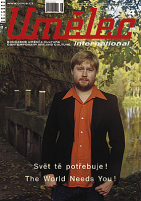| Zeitschrift Umělec 2001/4 >> Paintings to Live and Think By | Übersicht aller Ausgaben | ||||||||||||
|
|||||||||||||
Paintings to Live and Think ByZeitschrift Umělec 2001/401.04.2001 waanja | rezension | en cs |
|||||||||||||
|
Isabela Grosseová, Habitable Paintings, Gallery Jelení, Prague, 25 Sept. – 28 Oct., 2001
Making the transition from the relatively safe haven of a school studio into real life is often difficult for fresh graduates. This makes it crucial that galleries give them the opportunity to develop their graduation projects. And Isabela Grosseová, whose graduation series Habitable Paintings was exhibited at Gallery Jelení in Prague, certainly deserves the space. The title of the exhibition plants the work somewhere in the territory between visual art, architecture, and interior design — areas often touched upon by artists but never fully defined. Grosseová, who studied in the painting, architecture and intermedia studios at the Fine Arts Academy in Prague, says that the chief motivation for her work was breaking down what she calls the rigidity of contemporary architecture. What bothers her the most is that most of it seems to exist only for itself (or to be photographed) and leaves no space for human bodies, not to mention art. While foreign design artists are currently wrestling with social and political issues and how they relate to the utopian guidelines of the early avant-garde, Grosseová is unconcerned with such issues. She is more interested in the simple dialogue between art and architecture. Grosseová’s tablet paintings are actually three-dimensional objects that penetrate the exhibition space, some even allowing the viewer to rearrange their composition. All her work seems to have this workable quality, including the exhibition invitation with its somewhat boring colored stripes, made to be folded and designed. This variability is most evident in her “habitable embrasure,” which functions as a seat for two, or a lounge for one. The design and ergonomical aspects of this piece, which of all her work looks the most like furniture, do not play an important role here. Rather it’s the abstract geometric set of spatial elements whose austerity is intuitively tempered by lyrically colored surface areas. Effective use of color turns these objects into paintings. But like abstract painting’s transcendental universality, she brings them back to “serve the people.” The function of the mural paintings and painting screens remains ambiguous here and how they’re meant to be used as furniture is not immediately obvious. Grosseová painted the surrounding walls in the gallery and although she was unable to reach higher than the average wall painter, the rest of the color scheme and exhibition composition was easily within the reach of the artist’s intuition and judgment. This combination of precise thought and female lightness will go a long way toward helping Grosseová succeed in the all too masculine local art scene.
01.04.2001
Empfohlene Artikel
|
|||||||||||||








Kommentar
Der Artikel ist bisher nicht kommentiert wordenNeuen Kommentar einfügen